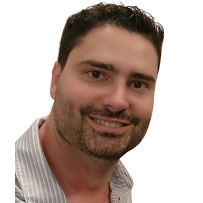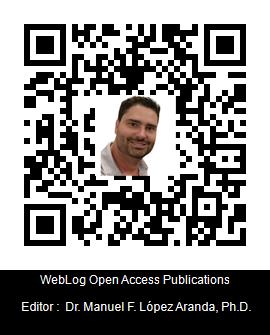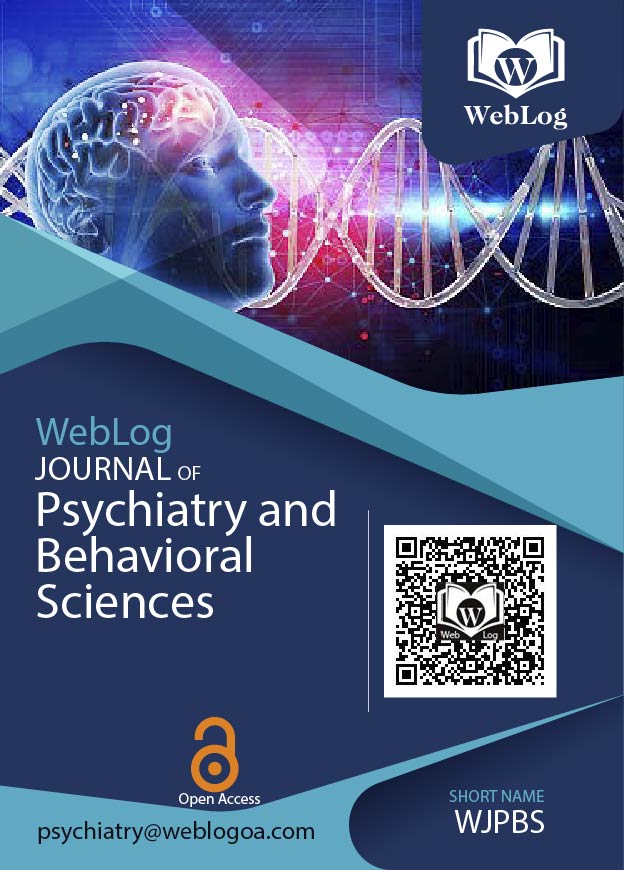Editor Profile

Dr. Manuel F. López Aranda, Ph.D.
Distinguished Researcher Professor
Present
Universidad de Málaga
Málaga
Spain

In 2004 I began my Ph.D. in the Neurobiology laboratory at CIMES, University of Malaga. I was granted a Predoctoral fellowship by the Ministerio de Educacion y Ciencia (Spain) and I obtained my European Ph.D. in 2010. During my Ph.D., the goal of my research was to explore the physiological functions of sGαi2 and RGS-14 proteins in the brain. Our results led to the publication of 5 first author papers (including a paper in the prestigious journal Science) that constituted my Thesis, (Lopez- Aranda et al., 2006; 2007; 2008; 2008; 2009). The most relevant results I obtained during my Ph.D. were those published in the journal Science (Lopez Aranda at al., 2009), this paper was published with an editorial from the journal Science, which indicates the high quality and relevance of these results. The press, radio and TV echoed the news of my results, to the point that some media named me as "the father of memory protein”. In that paper we showed the critical role of the layer 6 of V2 and the role of RGS-14 protein in the formation of long-term object memory.
During my Ph.D., I performed 2 training stays at international research laboratories: one, at Dept. of Neuroscience, University of Pittsburgh (USA) in 2007, to develop behavioral and microdialysis techniques in rodents; a second one at the INSERM (France) in 2009 to develop behavioral techniques in non-human primates. The results obtained during my Ph.D. were awarded with multiple national awards such as Winner of the best work of translational medicine prize, from Foundation Hospital of Madrid (2010) and Young Researcher award, from Foundation BIOGEN IDEC (2012), among others. In addition, I obtained the 1st prize of Spin-off projects from the Chamber of Commerce of Malaga (2009), and the Outstanding Thesis Award, from University of Malaga.
In 2010, I became a Postdoctoral Scholar in Dr. Alcino J Silva's lab. at University of California Los Angeles (UCLA; USA). In 2011 I was awarded with the prestigious Human Frontier Fellowship from the International Human Frontier Science Program Organization. In 2014 I obtained a grant as a Principal Investigator (PI), from the Children's Tumor Foundation (grant #: 2014-01-014) awarded with $108,000 for 2 years.
In 2016 I was promoted to Assistant Project Scientist in the same lab (UCLA). Since then, I’ve had the role of an independent researcher, developing innovative ideas, establishing collaborations, leading/mentorship a team of 10 UCLA undergraduates in the laboratory and writing papers. During this time, I was part of grants from Adelson Foundation (2012-2016), NIH (2015-2020) and National Institute of Mental Health (2018-2020). The research line that I led during this time studied the possible impact of environmental factors (i.e., post-natal immune activation) in the development of autistic phenotypes in a mouse model of Tuberous sclerosis (TSC; a disorder with high prevalence of autism). Our results showed that early post-natal immune activation resulted in profound impairments in social behavior. We also demonstrated the role of the microglia in those phenotypes and that they could be prevented or even permanently reversed with drugs that target mTOR and IFNβ signaling (Lopez-Aranda et al. 2021). Our results provided the first detailed mechanisms for how immune activation during these later stages of development, coupled to genetic susceptibility, could contribute to social memory and communication deficits (autistics phenotypes). As the leader of this project, I was delighted to find that our article attracted a lot of attention from the media and public. During my time at UCLA, I established interdisciplinary collaborations with different laboratories at UCLA, University of Malaga, Texas and Chicago as well as with the Pharmaceutical company Takeda (2014 to 2017). These collaborations led to several scientific publications (2010, 2013, 2014, 2019, 2020, 2021, 2022, 2023, 2024).
In 2022, I accepted a position in The Jackson Laboratory as Neurobehavioral Scientist. My role in this position was leading the behavioral team, to design and execute rodent behavior studies, data analysis and interpretation, development and enhancement of protocols, and training staff and personnel at The Jackson Laboratory (JAX) in complex and diverse neurobehavioral phenotyping paradigm; processing mouse phenotyping data, including quality control, statistical analysis, and biological interpretation for clients of The Center for Biometric Analysis (CBA).
In 2023, I joined the University of Malaga as an Investigador Distinguido Beatriz Galindo Senior at the department of Cell Biology, Genetic and Physiology.
- Learning and Memory
- Autism Spectrum Disorder
- Microglia
- mTOR
- Alzheimer's Disease
- Aging
- Neuroinflammation
- Mariam Masmudi-Martín, Irene Navarro-Lobato, Manuel F López-Aranda, et al. 2024. Brain areas interconnected to ventral pathway circuits are independently able to induce enhancement in object recognition memory and cause reversal in object recognition memory deficit. CNS Neurosci Ther. DOI: 10.1111/cns.14727.
- Mariam Masmudi-Martín*; Manuel F. López-Aranda* et al. 2024. A role of frontal association cortex in long-term object recognition memory of objects with complex features in rats. European Journal of Neuroscience. DOI:10.1111/ejn.16243.
- Manuel F. López-Aranda et al. 2024. Early post-natal immune activation leads to object memory deficits in female Tsc2+/- mice: The importance of including both sexes in neuroscience research. Biomedicines. DOI:10.3390/biomedicines12010203.
- Irene Navarro-Lobato, Mariam Masmudi-Martín, Manuel F. López-Aranda; et al. 2023. Promotion of area V2 neuronal structural plasticity prevents object recognition memory deficit in rodent models of aging and Alzheimer´s diseases. Neural Regeneration Research. DOI: 10.4103/1673-5374.389301.
- Manuel F. López-Aranda; et al. 2023. Role of Type I Interferon Signaling and Microglia in the Abnormal Long-term Potentiation and Object Place Recognition Deficits of Male Mice With a Mutation of the Tuberous Sclerosis 2 Gene. Biological Psychiatry: Global Open Science. DOI: 10.1016/j.bpsgos.2022.03.015.
- Irene Navarro-Lobato; Mariam Masmudi-Martín; Manuel F. López-Aranda; et al. 2022. RGS14414-Mediated Activation of the 14-3-3ζ in Rodent Perirhinal Cortex Induces Dendritic Arborization, an Increase in Spine Number, Long-Lasting Memory Enhancement, and the Prevention of Memory Deficits. Cerebral Cortex. DOI: 10.1093/cercor/bhab322.
- Manuel F. López-Aranda; et al. 2021. Postnatal immune activation causes social deficits in a mouse model of tuberous sclerosis: Role of microglia and clinical implications. Science Advances. DOI: 10.1126/sciadv.abf2073.
- Mariam Masmudi-Martín*; Irene Navarro-Lobato*; Manuel F. López-Aranda*; et al. 2020. Reversal of Object Recognition Memory Deficit in Perirhinal Cortex-Lesioned Rats and Primates and in Rodent Models of Aging and Alzheimer’s Diseases. Neuroscience. DOI: 10.1016/j.neuroscience.2020.08.039.
- Mariam Masmudi-Martín; Irene Navarro-Lobato; Manuel F. López-Aranda; et al. 2019. RGS14 414 treatment induces memory enhancement and rescues episodic memory deficits. The FASEB Journal. DOI: 10.1096/fj.201900429rr.
- Janel E. Le Belle; Jantzen Sperry; Amy Ngo; Yasmin Ghochani; Dan R. Laks; Manuel F. López-Aranda; et al. 2014. Maternal Inflammation Contributes to Brain Overgrowth and Autism-Associated Behaviors through Altered Redox Signaling in Stem and Progenitor Cells. Stem Cell Reports. DOI: 10.1016/j.stemcr.2014.09.004.
- Thomas Rogerson; Denise J. Cai; Adam Frank; Yoshitake Sano; Justin Shobe; Manuel F. López-Aranda; et al. 2014. Synaptic tagging during memory allocation. Nature Reviews Neuroscience. DOI: 10.1038/nrn3667.
- Antonella Caccamo; Andrea Magri; David X. Medina; Elena V. Wisely; Manuel F. López-Aranda; et al. 2013. mTOR regulates tau phosphorylation and degradation: implications for Alzheimer's disease and other tauopathies. Aging Cell. DOI: 10.1111/acel.12057.
- Irene Navarro-Lobato; Mariam Masmudi-Martín; Manuel F. López-Aranda; et al. 2010. A correlation of haloperidol-induced cognitive deficit with dysfunctional dopamine receptor activity in nonhuman primate. Open Access Animal Physiology. DOI: 10.2147/oaap.s7262.
- Juan F. López-Téllez; Manuel F. López-Aranda; et al. 2010. Prefrontal Inositol Triphosphate Is Molecular Correlate of Working Memory in Nonhuman Primates. Journal of Neuroscience. DOI: 10.1523/jneurosci.4565-09.2010.
- Manuel F. López-Aranda; et al. 2009. Role of Layer 6 of V2 Visual Cortex in Object-Recognition Memory. Science. DOI: 10.1126/science.1170869.
- Manuel F. López-Aranda; et al. 2008. A dynamic expression pattern of sGαi2protein during early period of postnatal rat brain development. International Journal of Developmental Neuroscience. DOI: 10.1016/j.ijdevneu.2008.03.010.
- Manuel F. López-Aranda; et al. 2008. Activation of caspase-3 pathway by expression of sGαi2 protein in BHK cells. Neuroscience Letters. DOI: 10.1016/j.neulet.2008.04.078.
- Manuel F. López-Aranda; et al. 2007. Role of a Gαi2 protein splice variant in the formation of an intracellular dopamine D2 receptor pool. Journal of Cell Science. DOI: 10.1242/jcs.005611.
- Manuel F. López-Aranda; et al. 2006. Localization of the GoLoco motif carrier regulator of G-protein signalling 12 and 14 proteins in monkey and rat brain. European Journal of Neuroscience. DOI: 10.1111/j.1460-9568.2006.04838.x.
- P. Fernández-LLebrez; J. M. Grondona; J. Pérez; Manuel F. López-Aranda; et al. 2004. Msx1-Deficient Mice Fail to Form Prosomere 1 Derivatives, Subcommissural Organ, and Posterior Commissure and Develop Hydrocephalus. Journal of Neuropathology & Experimental Neurology. DOI: 10.1093/jnen/63.6.574.
- Guillermo Estivill-Torrús; Manuel F. López-Aranda; et al. 2001. PAX6 and MSX1, two homeobox genes involved in the development of the subcommissural organ. Int. J. Dev. Biol. 45 (S1): S75-S76.

